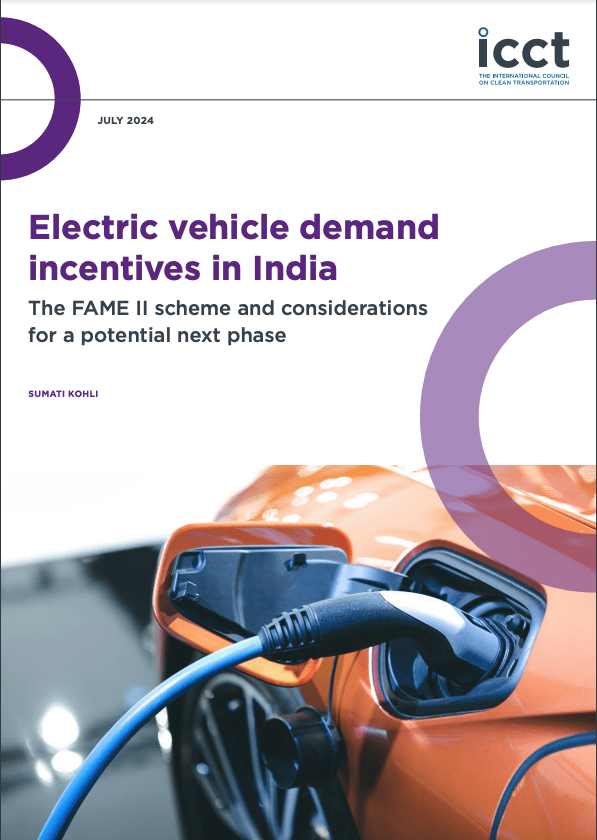Role of fuel efficiency norms in accelerating sales of electric vehicles in India
Blog
The India Clean Transportation Summit 2024: Behind the scenes at India’s leading clean transportation event
As of 2020, transportation in India contributed 14% of the country’s energy-related direct carbon dioxide emissions, and 90% of this came from road transport. Decarbonizing the transport sector is a crucial goal for the country. As India strives to achieve its climate and environmental objectives, it’s critical to have clear targets and defined intermediate milestones to help ensure that the pace of transition to clean transportation is in line with national goals. How will India achieve these goals?
This question was at the heart of the International Council on Clean Transportation’s second annual India Clean Transportation Summit (ICTS), held August 28 and 29, 2024. More than 100 high-level policymakers and experts in the fields of transportation and environmental policy attended this exclusive national event. The wider interested public learned more about the key themes of the summit through extensive media coverage in the Hindustan Times and other leading national outlets.
As India’s landmark transportation event, the ICTS platformed Indian leaders, policymakers, industry experts, and other key stakeholders to discuss how India can be a global leader in the transition to low-carbon, resilient transport systems.
The conference included a plenary session, four breakout sessions, four open-access sessions, and two networking events. The plenary session set the stage and framed the larger conversation in the Indian context, and the breakouts were high-level technical sessions that allowed participants to dive deeper into specific areas.
Opening plenary
At the plenary session that opened the summit, Additional Secretary at the Union Ministry of Heavy Industries Dr. Hanif Qureshi addressed the crowd. “There is a need to accelerate the adoption of electric trucks in India. Local manufacturing is essential not only for local growth, but also for cost reduction. Economics rather than technology is the key to scaling up e-truck deployment,” he explained.
Speaking at the same session, Mr. Sudhendu J. Sinha, Adviser (Infra Connectivity and Electric Mobility), NITI Aayog, said the government is already working on supporting the supply chain to accelerate the adoption of electric trucks. “On at least 13–16 items [EV components] the GSTs (Goods and Services Taxes) have been rationalized just to ensure that the supply chain is ready,” he said.
High-level technical sessions
The nine breakout sessions, conducted over two days, addressed key issues and opportunities in transport in India. The topics highlighted diverse issues and innovations shaping the future of sustainable mobility:
- Electric trucks: From margins to mainstream
- Accelerating zero-emission vehicle adoption through fuel consumption standards
- Decarbonizing light-duty vehicles in India
- ZEV alliance: Technology, policy, and infrastructure for e-tractors in India
- Low-emission zones (LEZs) to combat air pollution in Indian cities
- E-highways for e-freight in India
- Ramping up charging infrastructure for light-duty vehicles in India
- Real-world motor vehicle emissions in Delhi and Gurugram using remote sensing
- Innovation for impact: Neighborhood bus operations
Dialogue with EV users: Day 1 of the ICTS closed with a discussion with personal EV users from Delhi National Capital Region who shared their experiences and views on various aspects of operating an EV. While private EV owners said they feel confident about using electric cars, they also noted the need for better services like charging infrastructure.
Norway’s EV journey: In a fireside chat on Day 2 with Ashpreet Sethi, Facilitator, Road Rransport, Breakthrough Agenda, Markus Nilsen Rotevatn Project Lead at Norsk elbilforening (Norwegian EV Association), shared key insights on Norway’s EV journey. “In Norway, the consumer is not choosing the type of car based on environmentalism or any engagement with global issues. They are choosing it purely with their wallets [it is cost-effective],” he said. In Norway, all policies are aimed at leveling the playing field between EVs and fossil fuel cars. “Different policies were put together to ensure this economic factor pushed demand among consumers,” added Rotevatn.
 Markus Nilsen Rotevatn, Project Lead at Norsk elbilforening (Norwegian EV Association), and Ashpreet Sethi, Facilitator, Road Rransport, Breakthrough Agenda, at the fireside chat on Norway’s EV journey during the second day of ICTS.
Markus Nilsen Rotevatn, Project Lead at Norsk elbilforening (Norwegian EV Association), and Ashpreet Sethi, Facilitator, Road Rransport, Breakthrough Agenda, at the fireside chat on Norway’s EV journey during the second day of ICTS.
Also on Day 2, at the session on neighborhood bus operations, Transport and Environment Minister, Government of Delhi Mr. Kailash Gahlot highlighted how “extensive survey has been done” by assistant ticket inspectors (ATIs) and Indian Institutes of Technology are using AI to develop electric bus routes; the ICCT has been instrumental in helping develop these routes. “We will see the Mohalla buses on ground very soon as the depots are ready, and some initial routes have already been planned,” he said.
Other sessions examined the impacts of climate on transport in India, climate-smart public-private partnerships, and the role of India in the future of mobility. These sessions paved the way for longer-term collaboration among India’s leading policymakers and experts as they work to make the future of transportation in India more sustainable, resilient, and smart.
Looking forward
In its second year, attendees of the ICTS included mobility leaders, professionals, experts from academia and the private sector, and enthusiasts who joined us in this critical conversation both in person and online. Be it a policymaker, a CEO, a researcher, a student, or an advocate for sustainable mobility, their participation helped us shape and host these bold conversations toward greener, safer, and more resilient transport solutions in India.
How India deals with transportation today will shape the future of its people and there are direct implications for residents’ health, mobility, and overall safety. It’s important that governments at the local, state, and national levels work in tandem to build a cleaner transport sector for India’s future.
Author
Related Publications
ELECTRIC VEHICLE DEMAND INCENTIVES IN INDIA: THE FAME II SCHEME AND CONSIDERATIONS FOR A POTENTIAL NEXT PHASE
Analyzes the potential of a tax on individuals who fly often to raise revenue for the decarbonization of aviation This study offers insights on the second phase of Faster Adoption and Manufacturing of Hybrid and Electric Vehicles (FAME), India’s flagship electric vehicle (EV) promotion program, and present policy considerations for future demand incentives and other government support for EV adoption.


